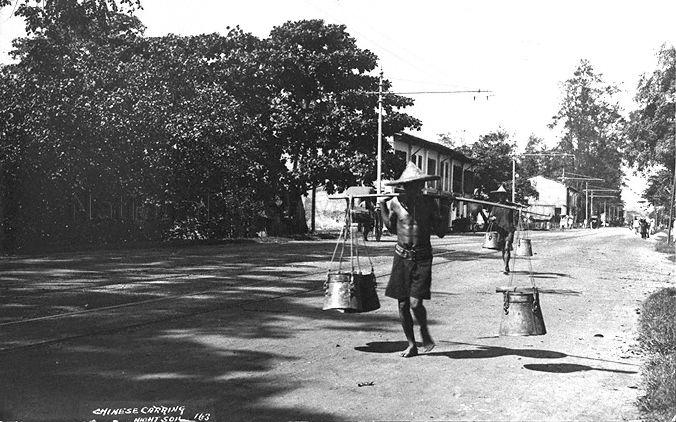The toilet is a convenient modern facility that we take for granted. We use the toilet, flush the bowl (hopefully) and wash our hands (also hopefully) without giving a second thought to the luxury of modern plumbing and sanitation.
With the exception of guys who have experienced what it's like living in the jungle without proper toilets during National Service, most of us will be blissfully ignorant of what life is like without First World conveniences.
It is perhaps difficult to imagine, then, that up till as recently as 1987, night soil collection was an actual business in Singapore.
What is "night soil", you might ask?
In the past, toilets with proper plumbing and sanitation were not widely available in Singapore. This meant that human waste could not be quickly, conveniently and cleanly flushed away via the toilets.
Toilets were essentially human waste collection points.
They fed into buckets that people peed or pooped did their business, well, into. They looked like this:
[caption id="" align="aligncenter" width="800"] Source[/caption]
Source[/caption]
These buckets were collected nightly and replaced with an empty one, hence the term "night soil".
And who does this nasty job of collecting night soil?
According to local historical site Roots.sg, up till the 1880s, Chinese syndicates would collect night soil and transfer the human waste to gardens and plantations at the outskirts of the city. Somewhat like this:
[caption id="" align="aligncenter" width="676"] A night-soil carrier in 1940. Source: NAS[/caption]
A night-soil carrier in 1940. Source: NAS[/caption]
Naturally, it was a highly manual and laborious process, so collections were not always done every single night — an inconvenience aggravated by the occasions where carriers failed to turn up for work or even went on strike.
These issues aside, they traversed the back alleys of shophouses to collect and replace night soil buckets through designated niches in the back walls of shophouses.
[caption id="" align="aligncenter" width="648"] Night-soil collectors in a back alley in 1952. Source: NAS[/caption]
Night-soil collectors in a back alley in 1952. Source: NAS[/caption]
If you were to walk down down the back lane of a row of a present-day conserved shophouses (like in Duxton, Chinatown and Little India), you are likely to come across the remnants of niches used for night soil collection.
The manual system of night soil collection also had its quirks, like this one logged by the Singapore Memory Project:
"It is interesting to note that if you were half way through your business, and the night soil carrier arrived to replace the bucket with an empty one, you would have to be fast enough to get out of the toilet before he replaced the bucket. Otherwise you would have to shout aloud to him to wait till your job was done."
As if this isn't enough, those who lived in the rural kampongs of Singapore's past, almost certainly found the experience of going to the toilet at night an extremely harrowing one:
"Mdm Cheng related to me that during her childhood days, toilet was a small attap and wooden structure a short walking distance at the back of the house. Going to the toilet in the night to do the 'big business' was a problem as it was dark at night and the walk to the toilet rather eerie and quiet. If one had to go to the toilet to find relief, a small kerosene lamp or lighted candle would help. Using a torchlight would not be practical and useful as it would not give a bright enough shine to cover a big area. So for those who feared going in the dark and quiet in the night to get to the toilet, they would do their big business at home using a spittoon."
With all that in mind about what toilets were like in the past, imagine our past generations, including our parents, grandparents, old guard leaders and even famous people like Albert Einstein and Charlie Chaplin, having to live without the kinds of toilets that we have today.
It is no wonder then that Chaplin's brother, Sidney called our island “Stinkapore” when he visited in 1932.
Let's be thankful for being able to flush away all our shit night-soil in our modern toilets.
Top image from NAS
If you like what you read, follow us on Facebook and Twitter to get the latest updates.
If you like what you read, follow us on Facebook, Instagram, Twitter and Telegram to get the latest updates.
